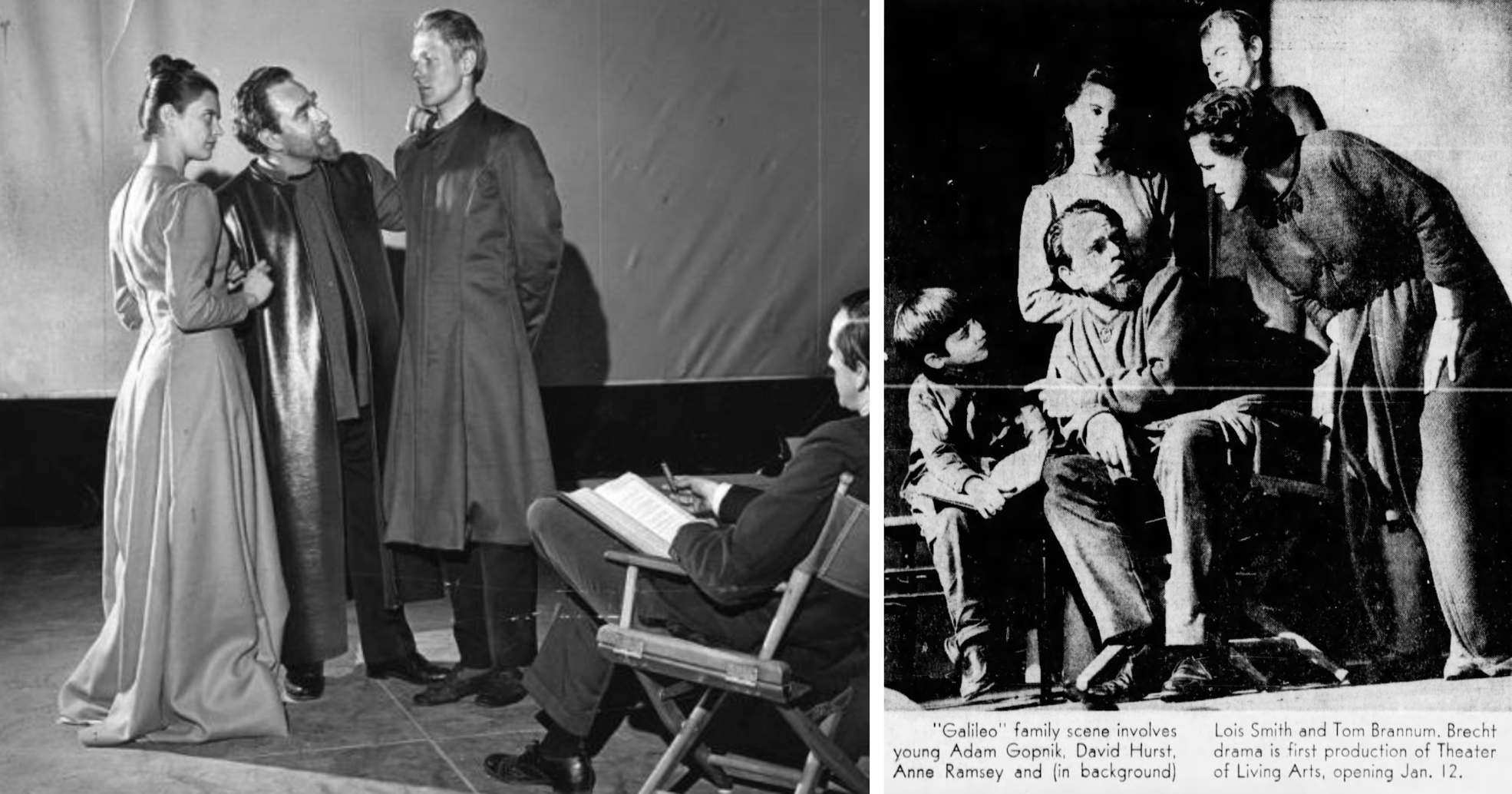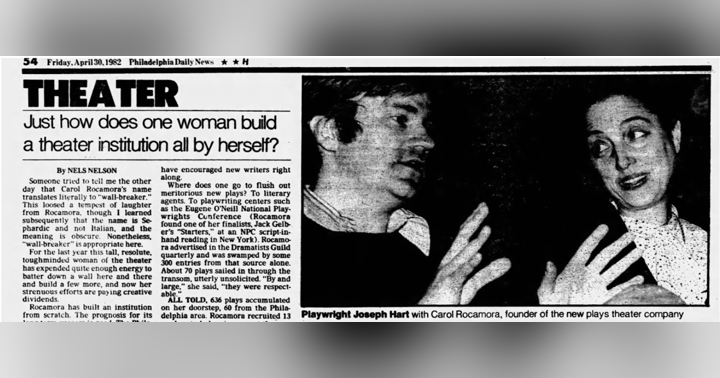
A photo of Celia Silverman and Jean Goldman, sitting in the seats of the newly-created Theatre of the Living Arts. This was the opening page of an article about the TLA in the Philadelphia Inquirer Magazine on February 28th, 1965. Below, a page from a promotional article about the theater, showing its location (marked with a large "T" in a circle) in relation to the Society Hill neighborhood to the north.
In the scheme proposed by the Philadelphia City Planning Commission, the Crosstown Expressway would cut across the bottom of Center City and create a "traffic loop." It was all part of a grand plan that envisioned the city hosting yet another World's Fair in West Fairmount Park by 1976. (This plan, of course, would never come to fruition.) The highways for cars would be joined by an electric tram line along Chestnut Street, and fairgoers could also take an aerial cable car up the Schuylkill River. At any rate, as can be seen below, the site where the TLA stood would have been part of the exit ramp for the Delaware Expressway (I-95).
Despite all these plans, only the massive Vine Street Expressway (or I-676) to the north of Center City was ever actually constructed. But it's worth noting that the Crosstown Expressway to the south was still actively being pursued as late as 1974, when it was finally formally abandoned in the face of sustained and vociferous opposition from residents. So the founders of the TLA created a theater on South Street in spite of the threat that the entire neighborhood might soon be razed! Apparently, if it came to that, they hoped to be able to move to a new and grander building elsewhere in the city.
In the archives of the Historical Society of Pennsylvania are many, many documents from the files of the Theatre of the Living Arts - about three dozen boxes! These contain everything from fundraising letters to box office reports. Among them was a typewritten document with a clear description of how the company was developed and organized and marketed. Here are two significant pages, describing the "community dialogue" held in March 1964. It clearly lays out the current state of Philadelphia's theater world, the progress already made on the theater building, and its founders' plans to be part of a wide-ranging arts organization. Significantly, we can see that Ted Mann of the Circle in the Square off-Broadway company spoke (apparently about why his company's earlier efforts in Philly had failed), as did André Gregory.
Gregory's topic (apparently delivered off-the-cuff, and without notes) was about 'Theater in Other Cities.' This is the earliest archival connection I can find of Gregory's involvement with the Theatre of the Living Arts. He was not yet designated as the Artistic Director, however.
Below, a pensive shot of André Gregory by the photographer Betty Nettis Bennett - a friend of his, who documented most of his work at the TLA - here he is waiting to be introduced to Philadelphians in May of 1965 - see below.
In fact, while conducting additional research in the archives of the Free Library of Philadelphia (where there is also a great deal of material about the TLA), I found a photo from a Theatre of Living Arts promotional pamphlet. This pamphlet was intended to document significant events in the ongoing campaign to found and fund the new company. Shown here is the audience of Philadelphians at a subsequent meeting at the Barclay Hotel in March of 1964. Mayor James Tate is addressing them from the podium, saying, "This is an inspired idea that will greatly enrich the cultural resources of our City. I pledge every possible help from my Administration to ensure its success." (One can hardly help noticing that the assembled crowd listening to Tate is almost entirely white, in a city that had a significant African American population. We will take up this issue more fully in our next episode.) Theodore Mann, then the leader of the Off-Broadway company Circle in the Square, also spoke to the audience.
Below, a photo of the same event, during which André Gregory was officially announced as the artistic director, as printed in the Philadelphia Inquirer on May 10th, 1965. From the accompanying story: "With the decline in quantity and quality of Broadway shows sent 'on the road,' 41 cities in the U.S. have already organized their own professional theatres, many with resident producing companies (including Hartford, Washington, Seattle, Milwaukee, San Francisco, Minneapolis, Houston, Oklahoma City). Philadelphia has now decided to satisfy its unmet needs for theatre of quality in the same way."
Above, a photo of the marquee of the almost completely renovated Theatre of the Living Arts (formerly the Model Theatre, a small neighborhood movie house) at 334 South Street. Judging from the string of Christmas decorations, the image seems to date from December 1965. One can just barely make out the words "Theatre of the Living Arts" on the poster to the left of the front doors, and to the right seems to be a listing of plays for the "Inaugural Season." We can see the windows on the second floor, where the company's office space was located. An air conditioning system, recently installed, can be glimpsed on the roof.
Below, a ground plan of the proposed renovations to the building, to create the audience and performance spaces of Theater of the Living Arts, as originally designed by Frank Weise. (One can note that there was very little room backstage or in the wings, making set changes during shows difficult. Therefore almost every show designed for the space tended to have a single unitary set.)
Above, two rehearsal photos (apparently staged for publicity purposes), dating from December 1964. To the left, from the Evening Bulletin, André Gregory directing Lois Smith, David Hurst and Tom Brannum. To the right, from the Inquirer, a shot that shows Smith, Hurst and Brannum, as well as the actress Anne Ramsey - and the young Adam Gopnik.
Finally, on the opening night of Galileo, the audience gathers in the lobby. (From the Philadelphia Inquirer Magazine, with the caption: "From marquee to stage, the Theatre of the Living Arts is a model of modernity.")
Selected Bibliography:
Books and Online Articles
Clark, Joseph S. Jr., and Dennis J. Clark, "Rally and Relapse: 1946-1968" in Philadelphia: A 300-Year History, Russel F. Weigley, ed., W.W. Norton & Company, 1982, pp. 649-703.
Gregory, André and Todd London, This Is Not My Memoir, Farrar, Strauss & Giroux, 2020.
Haumann, Sebastian, "Crosstown Expressway," The Encyclopedia of Greater Philadelphia, copyright Rutgers University, 2015. https://philadelphiaencyclopedia.org/essays/crosstown-expressway/
Hoffman, Warren, The Great White Way: Race and the Broadway Musical. Rutgers University Press, 2014, p. 109.
London, Todd, An Ideal Theater: Founding Visions for a New American Art, Theatre Communications Group, 2013, pp. 355-358.
McCarthy, Jack, “South Street (Song)”, The Encyclopedia of Greater Philadelphia, copyright Rutgers University, 2017. https://philadelphiaencyclopedia.org/archive/south-street-song/
Novick, Julius, Beyond Broadway: The Quest for Permanent Theatres (Dramabook Edition), Hill and Wang, 1969.
Tenenbaum, Jeremy Eric, "Saving South Street Through the Lens of Denise Scott Brown," in Hidden City Philadelphia (website), February 4, 2020. https://hiddencityphila.org/2020/02/saving-south-street-through-the-lens-of-denise-scott-brown/
Yee, Mary, “Vine Street Expressway”, The Encyclopedia of Greater Philadelphia, copyright Rutgers University, 2015. https://philadelphiaencyclopedia.org/archive/vine-street-expressway/
Zeigler, Joseph Wesley, Regional Theatre: The Revolutionary Stage. University of Minnesota Press, 1973, pp. 111-112.
Newspaper Articles (in chronological order)
"Living Arts Breathing" by Jerry Gaghan, Philadelphia Daily News, March 20, 1964, p. 49.
"Inaugural Season of the Theatre of Living Arts, Philadelphia Inquirer, May 10, 1964.
"South Street Gets Dash of High Society" by Jay Apt, Philadelphia Daily News, January 7, 1965, p. 5.
"'Galileo' Is Played to Its Scientific and Dramatic Hilt," by Henry Murdoch, Philadelphia Inquirer, January 13, 1965. p. 26.
"A Theatrical Baby With Two Mothers" by Edgar Williams, Philadelphia Inquirer Magazine, February 22, 1965.
Archival Documents (Theatre Collection of the Free Library of Philadelphia)
Goldman, Frederick, "Theatre of the Living Arts" (typescript).
McLaughlin, Patricia, "Theatre of the Living Arts: The Early Years of Philadelphia's First Resident Theater." Prepared as a report to a meeting of Literary Managers and Dramaturgs of the Americas, June 1991.
Archival documents (Collection of the Historical Society of Pennsylvania)
"Organizational Meeting, Theatre of the Living Arts, Thursday, March 19, 1964"
"The Theatre of the Living Arts," Athenaeum Annals, Vol X, No. 7, March 1964.



















